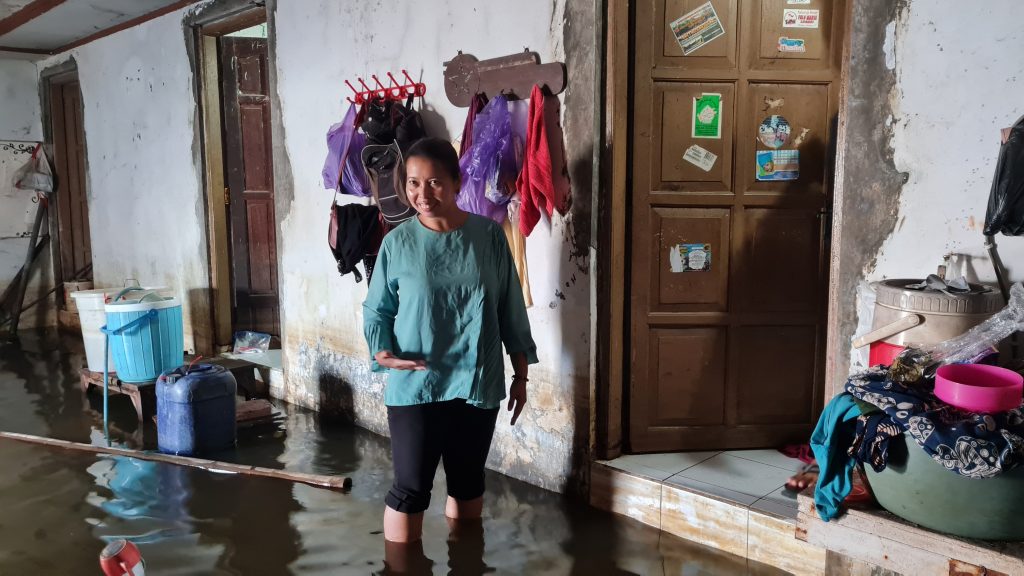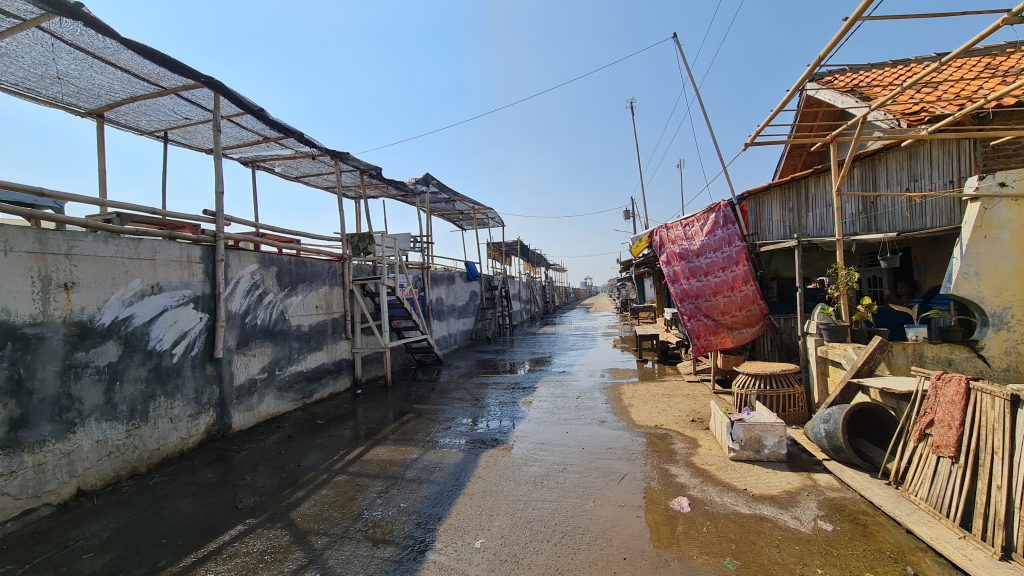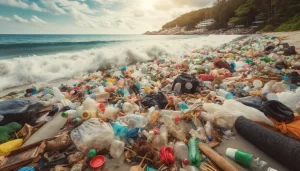
by Nabiha Shahab
Pekalongan, Central Java – For almost three years Ahmad, 42, his wife Sofyah, 39, and their three children have lived in a ‘waterworld’. Their home, a three-bedroom house in the Pasirsari neighbourhood in west Pekalongan has been flooded most of the time since 2019. Pasirsari, about four kilometres inland, is now mostly below the level of a nearby river.
Increasing sea levels, among other factors, contributes to Pekalongan and other areas on the north coast of Central Java province to suffer from frequent flooding, especially during high tides.
Ahmad and his family live in a relatively new housing complex, facing an open field the size of a football pitch, that is now almost completely covered with water. They do not own the house. The house owner and their family have long since moved to a different neighbourhood on higher grounds.
“They usually rent out the house, but they allow us to live here for free as long as we keep good care of it,” Sofyah told tanahair.net, adding that whatever money they set aside for rent, they use to buy sand to raise the floor of the house.
Many of the houses in Pasirsari remain only their top half visible. House owners raise the floor of their houses, but do not have enough funds to raise the roof, causing the house to appear sinking.

Ahmad works as a contract electrical repairman and does odd jobs said that he would prefer to live in a better place but is left with little choice considering their economic condition.
Sofyah said she only saw the house floor tiles for about four months after they moved in. After that the house has always been inundated by at least 30 centimetres of water. She spent most of her time in the bedroom section of the house that is raised about 50 centimetres. However, there are also times when the water rises to more than one metre.
At one of the corners in front of the bedroom, Sofyah has a table set up as her kitchen. She said electricity still works in the house although she’s worried that the sockets are getting lower as they keep raising the floor. The municipal water company does not serve the area anymore and they get their water from Pamsimas, a community-based clean water and sanitation program led by the Ministry of Public Works and Public Housing.
Living in such extreme conditions, health problems, electricity, clean water and sanitation are not the family’s only concern. “We often see snakes … almost every day actually … the other day we have a monitor lizard visiting” said Sofyah matter-of-factly.

Walled off city
Pekalongan city, around 100 kilometres west of the provincial capital Semarang that also suffers the same problem with tidal flooding. Tidal floods have historically flooded inland areas during high tide, but increasingly became higher and more persistent in the past five to ten years, affecting entire neighbourhoods in coastal areas in the north coast of Central Java.
In an apparent haphazard manner, massive sea dykes projects started to wall off the city. In the north part of the city known as ‘Boom beach’, traditionally a local tourist spot, now stands a 2-metre wall, more than one metre thick and around one kilometre long, protecting nearby community houses from intruding sea water.

A couple of kilometres west in Panjang, a massive seawall was built in 2018 all the way out westward. Curiously, the dyke was built up to three kilometres inland. This caused vast areas of previously shrimp farms, padi fields and mangrove patches north to the seawall now permanently under water.
In June, a river dyke near Pasirsari broke, flooding thousands of houses. As recently as Monday (18/7), tidal floods again flooded the north part of Pekalongan between 40 and 70 centimetres.
Arif Gandapurnama from Mercy Corps, an organisation focusing on urban resilience, said that 1,478 hectares of land in Pekalongan city has been permanently flooded in 2020. He designed a 15-year forecast model factoring in sea water rise, land subsidence and other factors and found that “areas in Pekalongan that will be permanently flooded could reach up to nine kilometres from the coastline, covering an area about 5,700 hectares”.
“We fear that most areas that will be impacted are fisheries, agriculture and settlements. We urgently need to find a solution to save thousands of households that will potentially lose their livelihood,” said Gandapurnama.
Batik city
Tidal floods and sea water rise are not the only contributing factors on the sinking of Pekalongan. Known for the country’s Batik city, Pekalongan and surrounding areas is home to hundreds of small and medium scale batik producers. In 2014, Pekalongan became a part of UNESCO’s Creative Cities Network as a creative city of crafts and folk arts.
The batik industry uses a lot of water, most of which is pumped from the ground. Excessive use of groundwater contributed to land subsidence in the city. “Our research in 2019 shows that on average land subsidence rate is 17 centimetres every year. There is another research that shows higher rates in some areas up to 30 centimetres per year,” said Gandapurnama.
“Pekalongan sits on young sediment, so massive groundwater extraction causes the land surface to subside,” he said.
The city has no optimum communal batik wastewater management, so excess from the batik production process gets dumped into the rivers. Wastewater from the industry includes chemical colouring and heavy metals that enters the waterway without any treatment.
The situation seems dire for Pekalongan. Without proper management, the city will be mostly underwater in a not so distant future.
update 21 July 2022, 16:42. Paragraph on wastewater management to: ‘an optimum communal batik wastewater management’
Banner photo: Many of the houses in Pasirsari, Pekalongan, remain only their top half visible. House owners raise the floor of their houses, but do not have enough funds to raise the roof, causing the house to appear sinking. Photo taken on 2 July 2022 (tanahair.net/nsh)
Tanahair.net would like to thank Arif Gandapurnama from Mercy Corps, Imam Nur Huda from Earthworm, Dicko Handono from the local community for their help during the article research and writing.















